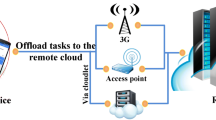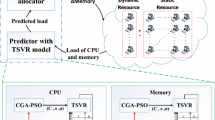Abstract
In order to reduce the energy consumption in the cloud data center, it is necessary to make reasonable scheduling of resources in the cloud. The accurate prediction for cloud computing load can be very helpful for resource scheduling to minimize the energy consumption. In this paper, a cloud load prediction model based on weighted wavelet support vector machine(WWSVM) is proposed to predict the host load sequence in the cloud data center. The model combines the wavelet transform and support vector machine to combine the advantages of them, and assigns weight to the sample, which reflects the importance of different sample points and improves the accuracy of load prediction. In order to find the optimal combination of the parameters, we proposed a parameter optimization algorithm based on particle swarm optimization(PSO). Finally, based on the WWSVM model, a load prediction algorithm is proposed for cloud computing using PSO-based weighted support vector machine. The Google cloud computing data set is used to verify the algorithm proposed in this paper by experiments. The experiment results indicate that comparing with the wavelet support vector machine, autoregressive integrated moving average, adaptive network-based fuzzy inference system and tuned support vector regression, the proposed algorithm is superior to the other four prediction algorithms in prediction accuracy and efficiency.







Similar content being viewed by others
Explore related subjects
Discover the latest articles and news from researchers in related subjects, suggested using machine learning.References
Barati M, Sharifian S (2015) A hybrid heuristic-based tuned support vector regression model for cloud load prediction. J Supercomput 71(11):4235–4259
Bui DM, Nguyen HQ, Yoon Y, Jun S, Amin MB, Lee S (2015) Gaussian process for predicting cpu utilization and its application to energy efficiency. Appl Intell 43(4):874–891
Calheiros RN, Masoumi E, Ranjan R, Buyya R (2015) Workload prediction using arima model and its impact on cloud applications’ qos. IEEE Trans Cloud Comput 3(4):449–458
Catalao J, Pousinho H, Mendes V (2011) Hybrid wavelet-pso-anfis approach for short-term wind power forecasting in portugal. IEEE Trans Sustain Energy 2(1):50–59
Cortes C, Vapnik V (1995) Support-vector networks. Machine Learn 20(3):273–297
Dabrowski C, Hunt F (2009) Using Markov chain analysis to study dynamic behaviour in large-scale grid systems. In: Proceedings of the Seventh Australasian symposium on grid computing and e-research, vol 99. Australian Computer Society, Inc, pp 29–40
Di S, Kondo D, Cirne W (2012) Characterization and comparison of cloud versus grid workloads. In: 2012 IEEE International conference on cluster computing (CLUSTER). IEEE, pp 230–238
Di S, Kondo D, Cirne W (2012) Host load prediction in a google compute cloud with a bayesian model. In: Proceedings of the international conference on high performance computing, networking, storage and analysis. IEEE Computer Society Press, p 21
Duy TVT, Sato Y, Inoguchi Y (2011) Improving accuracy of host load predictions on computational grids by artificial neural networks. Parallel Algor Appl 26(4):275–290
Foster I, Zhao Y, Raicu I, Lu S (2008) Cloud computing and grid computing 360-degree compared. In: Grid Computing environments workshop, 2008. GCE’08. IEEE, pp 1–10
Hu R, Jiang J, Liu G, Wang L (2013) Kswsvr: a new load forecasting method for efficient resources provisioning in cloud. In: 2013 IEEE International conference on services computing (SCC). IEEE, pp 120–127
Hu R, Jiang J, Liu G, Wang L (2014) Efficient resources provisioning based on load forecasting in cloud. Sci World J, 2014
Islam S, Keung J, Lee K, Liu A (2012) Empirical prediction models for adaptive resource provisioning in the cloud. Futur Gener Comput Syst 28(1):155–162
Li J, Li B (2014) Parameters selection for support vector machine based on particle swarm optimization. In: International conference on intelligent computing. Springer, pp 41–47
López M., Valero S, Senabre C, Aparicio J, Gabaldon A (2012) Standardization of short-term load forecasting models. In: 2012 9th International conference on the European energy market (EEM). IEEE, pp 1–7
Mallat SG (1989) A theory for multiresolution signal decomposition: the wavelet representation. IEEE Trans Pattern Anal Mach Intell 11(7):674–693
Müller KR, Smola A, Rätsch G, Schölkopf B, Kohlmorgen J, Vapnik V (1999) Using support vector machines for time series prediction. Adv Kernel Methods—Support Vector Learn, 243–254
Poli R, Kennedy J, Blackwell T (2007) Particle swarm optimization. Swarm Intell 1(1):33–57
Prevost JJ, Nagothu K, Kelley B, Jamshidi M (2011) Prediction of cloud data center networks loads using stochastic and neural models. In: 2011 6th International conference on system of systems engineering (SoSE). IEEE, pp 276–281
Rasheduzzaman M, Islam MA, Rahman RM (2014) Workload prediction on google cluster trace. Int J Grid High Perform Comput (IJGHPC) 6(3):34–52
Smola AJ, Schölkopf B (2004) A tutorial on support vector regression. Statist Comput 14(3):199–222
Sreelakshmi K, Kumar PR (2008) Performance evaluation of short term wind speed prediction techniques. In: IJCSNS International journal of computer science and network security. Citeseer
Tang L, Ma K, Li Z (2017) A new scheduling algorithm based on ant colony algorithm and cloud load balancing. J Inf Hid Multimed Signal Process 8:191–199
Wu Y, Yuan Y, Yang G, Zheng W (2007) Load prediction using hybrid model for computational grid. In: IEEE/ACM International conference on grid computing, pp 235–242
Xu Dy, Yang Sl, Liu Rp (2013) A mixture of hmm, ga, and elman network for load prediction in cloud-oriented data centers. J Zhejiang Univ Sci C 14(11):845–858
Yang Q, Peng C, Zhao H, Yu Y, Zhou Y, Wang Z, Du S (2014) A new method based on psr and ea-gmdh for host load prediction in cloud computing system. J Supercomput 68(3):1402–1417
Zeng J, Qiao W (2012) Short-term wind power prediction using a wavelet support vector machine. IEEE Trans Sustain Energy 3(2):255–264
Zhang L, Zhou W, Jiao L (2004) Wavelet support vector machine. IEEE Trans Syst Man Cybern Part B (Cybern) 34(1):34–39
Zhang Q, Benveniste A (1992) Wavelet networks. IEEE Trans Neural Netw 3(6):889–898
Zhang Q, Zhani MF, Boutaba R, Hellerstein JL (2013) Harmony: dynamic heterogeneity-aware resource provisioning in the cloud. In: 2013 IEEE 33rd International conference on distributed computing systems (ICDCS). IEEE, pp 510–519
Zhong W, Zhuang Y, Sun J, Gu J (2017) The cloud computing load forecasting algorithm based on wavelet support vector machine. In: Proceedings of the Australasian computer science week multiconference. ACM, p 38
Acknowledgment
This work is supported by the National Natural Science Foundation of China (General Program) under Grant No. 61572253, ”13th Five-Year Plan” Equipment Pre-Research Projects Fund under Grant No. 61402420101HK02001, Aviation Science Fund under No. 61202351.
Author information
Authors and Affiliations
Corresponding author
Rights and permissions
About this article
Cite this article
Zhong, W., Zhuang, Y., Sun, J. et al. A load prediction model for cloud computing using PSO-based weighted wavelet support vector machine. Appl Intell 48, 4072–4083 (2018). https://doi.org/10.1007/s10489-018-1194-2
Published:
Issue Date:
DOI: https://doi.org/10.1007/s10489-018-1194-2




